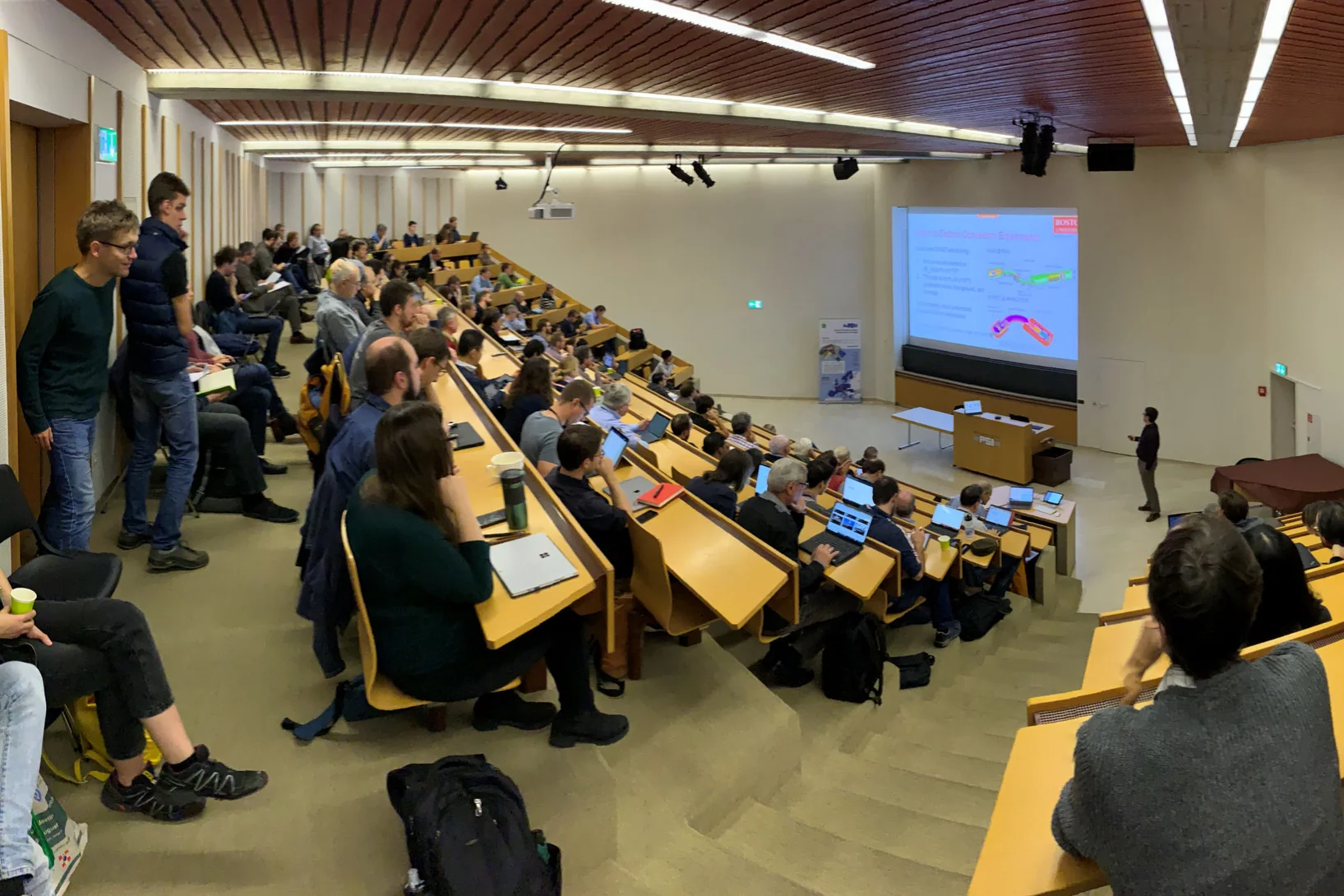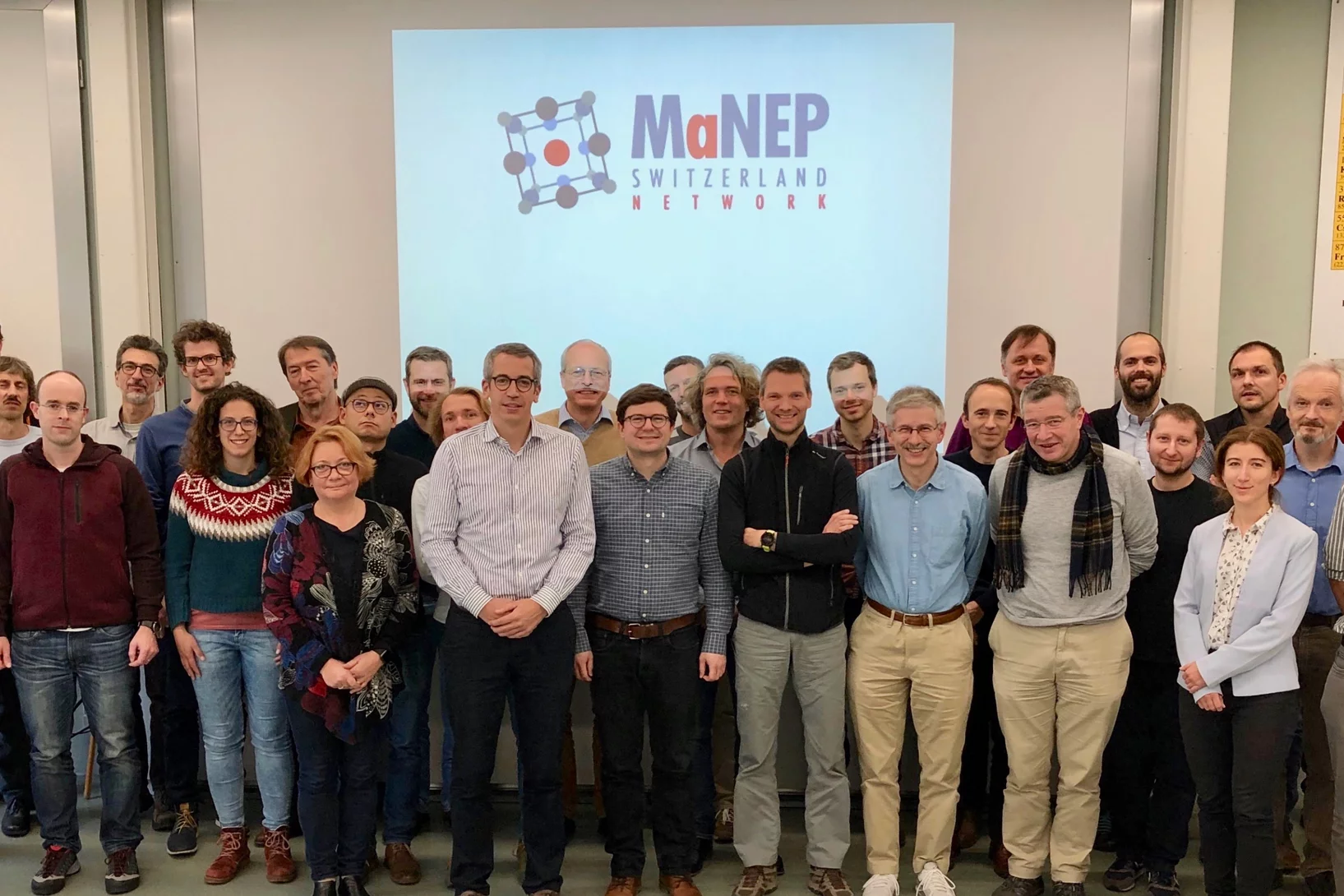Here you find current and previous news from the NUM division. For scientific highlights, please have a look here.
Reversible spin storage in metal oxide - fullerene heterojunctions
We show that hybrid MnOx/C60 heterojunctions can be used to design a storage device for spin-polarized charge: a spin capacitor. Hybridization at the carbon-metal oxide interface leads to spin-polarized charge trapping after an applied voltage or photocurrent. Strong electronic structure changes, including a 1-eV energy shift and spin polarization in the C60 lowest unoccupied molecular orbital, are then revealed by x-ray absorption spectroscopy, in agreement with density functional theory simulations.
Quantifying Diffusion through Interfaces of Lithium-Ion Battery Active Materials
Detailed understanding of charge diffusion processes in a lithium-ion battery is crucial to enable its systematic improvement. Experimental investigation of diffusion at the interface between active particles and the electrolyte is challenging but warrants investigation as it can introduce resistances that, for example, limit the charge and discharge rates. Here, we show an approach to study diffusion at interfaces using muon spin spectroscopy.
Current-driven magnetic domain-wall logic
Spin-based logic architectures provide nonvolatile data retention, near-zero leakage, and scalability, extending the technology roadmap beyond complementary metal–oxide–semiconductor logic. Architectures based on magnetic domain walls take advantage of the fast motion, high density, non-volatility and flexible design of domain walls to process and store information. Such schemes, however, rely on domain-wall manipulation and clocking using an external magnetic field, which limits their implementation in dense, large-scale chips.
Broken time-reversal symmetry in the topological superconductor UPt3
Topological properties of materials are of fundamental as well as practical importance. Of particular interest are unconven- tional superconductors that break time-reversal symmetry, for which the superconducting state is protected topologically and vortices can host Majorana fermions with potential use in quantum computing. However, in striking contrast to the unconventional A phase of superfluid 3He where chiral symmetry was directly observed, .....
Symposium in memory of Jean-Pierre Blaser
Jean-Pierre Blaser (1923-2019) was one of the founders of the Swiss Institute for Nuclear Research SIN - one of the two institutions, which merged to the Paul Scherrer Institut in 1988. From 1988-1990 he was the first Director of the Paul Scherrer Institut. On the occasion of his first obit ETH Zurich and PSI organised a symposium to honour the lifetime achievement of this outstanding Swiss physicist.
Dem Rätsel der Materie auf der Spur
Forschende haben an der Quelle für ultrakalte Neutronen des PSI eine Eigenschaft des Neutrons so genau wie noch nie vermessen: sein elektrisches Dipolmoment. Denn bis heute wird nach einer Erklärung gesucht, weshalb es nach dem Urknall mehr Materie als Antimaterie gab.
Kurzfilm eines magnetischen Nanowirbels
Mit einer neu entwickelten Untersuchungsmethode konnten Forschende die magnetische Struktur im Inneren eines Materials mit Nanometer-Auflösung abbilden. Ihnen gelang ein kurzer «Film» aus sieben Bildern, der erstmalig in 3-D zeigt, wie sich winzige Wirbel der Magnetisierung tief im Inneren eines Materials verändern.
Observation of a Charge-Neutral Muon-Polaron Complex in Antiferromagnetic Cr2O3
We report a comprehensive muon spin rotation (μSR) study of the prototypical magnetoelectric antiferromagnet Cr2O3. We find the positively charged muon (μ+) occupies several distinct interstitial sites and displays a rich dynamic behavior involving local hopping, thermally activated site transitions, and the formation of a charge-neutral complex composed of a muon and an electron polaron.
A link between quantum magnetism and electronic band topology
Muon spin rotation experiments establish a quantitative link between the magnetic and topological electronic properties of the kagome magnet Co3Sn2S2 — and demonstrate effective ways for tuning these properties.
Tunable anomalous Hall conductivity through volume-wise magnetic competition in a topological kagome magnet
Magnetic topological phases of quantum matter are an emerging frontier in physics and material science. Along these lines, several kagome magnets have appeared as the most promising platforms. Here, we explore magnetic correlations in the kagome magnet Co3Sn2S2. Using muon spin-rotation, we present evidence for competing magnetic orders in the kagome lattice of this compound.
Possible room-temperature signatures of unconventional 4f-electron quantum criticality in YbMn6Ge6−xSnx
We investigate the Sn composition dependence of the Yb valence and local magnetization in YbMn6Ge6−xSnx (4.25 ≤x≤ 5.80) using x-ray absorption spectroscopy (XANES) and x-ray magnetic circular dichroism at the Yb L3 edge. In these materials, where Mn is ferromagnetically ordered, we observe a decrease of the Yb valence upon reducing the chemical pressure by Sn doping and a suppression of the Yb magnetic moment for strongly hybridized 4f states (ν ∼ 2.77).
Magnetism and anomalous transport in the Weyl semimetal PrAlGe: possible route to axial gauge fields
In magnetic Weyl semimetals, where magnetism breaks time-reversal symmetry, large magnetically sensitive anomalous transport responses are anticipated that could be useful for topological spintronics. The identification of new magnetic Weyl semimetals is therefore in high demand, particularly since in these systems Weyl node configurations may be easily modified using magnetic fields. Here we explore experimentally the magnetic semimetal PrAlGe, and unveil a direct correspondence between easy-axis Pr ferromagnetism and anomalous Hall and Nernst effects.
Anna Sótér starts Ambizione fellowship
Anna Sótér has started an Ambizione fellowship at ETH Zurich and PSI. Her project is dedicated to developing a novel source of cold muonium atoms, which will be used for a new interferometry experiment that enables testing the weak equivalence principle by directly probing gravitational interaction of antimatter.
Gut lackierte Geigen spielen länger
Traditionell werden Geigen lackiert, um sie vor Luftfeuchtigkeit und anderen Umwelteinflüssen zu schützen. Ein Wissenschaftler-Team hat am PSI untersucht, welchen Einfluss unterschiedliche Anstriche auf das Instrument haben. Tatsächlich sollte man auf den Lack keinesfalls komplett verzichten.
Topological Magnetic Phase in the Candidate Weyl Semimetal CeAlGe
We report the discovery of topological magnetism in the candidate magnetic Weyl semimetal CeAlGe. Using neutron scattering we find this system to host several incommensurate, square-coordinated multi-k⃗ magnetic phases below TN. The topological properties of a phase stable at intermediate magnetic fields parallel to the c axis are suggested by observation of a topological Hall effect.
Modelling and simulation pay off
Researchers in the Laboratory for Scientific Computing and Modelling at the Paul Sherrer Institute PSI solve the most complex problems through a combination of theory, modelling, and high-performance computing. With powerful computers, they simulate the smallest molecules or large-scale research facilities.
Modellieren und Simulieren zahlt sich aus
Forschende des Labors für Simulation und Modellierung des PSI lösen durch die Kombination von Theorie, Modellierung und Hochleistungsrechnen komplexeste Probleme. Mit leistungsfähigen Computern simulieren sie kleinste Moleküle oder Grossforschungsanlagen.
Workshop on the Physics of Fundamental Symmetries and Interactions
The 5th Workshop on the Physics of Fundamental Symmetries and Interactions (PSI2019) took place from 20 to 25 October 2019 at PSI, bringing together 200 scientists from all over the world working on some of today’s most precise particle-physics experiments at the low-energy frontier.
Determination and evaluation of the nonadditivity in wetting of molecularly heterogeneous surfaces
Every folded protein presents an interface with water that is composed of domains of varying hydrophilicity/-phobicity. Many simulation studies have highlighted the nonadditivity in the wetting of such nanostructured surfaces in contrast with the accepted theoretical formula that is additive. We present here an experimental study on surfaces of identical composition but different organization of hydrophobic and hydrophilic domains.
TecDay: LMX meets Hohe Promenade
TecDay is an SATW initiative that was developed at the Kantonsschule Limmattal in 2007 and has since been rolled out to more than 60 secondary schools across Switzerland. By the end of 2017 it had reached around 45,000 students and 5,000 teachers. In December 2019 the LMX contributed in one module, that received a total of 16 students over the course of a morning. The module was organized in three different “stations”, each one focusing on one topic or area that the group is working on.
Field-induced double spin spiral in a frustrated chiral magnet
Magnetic ground states with peculiar spin textures, such as magnetic skyrmions and multifunctional domains are of enormous interest for the fundamental physics governing their origin as well as potential applications in emerging technologies. Of particular interest are multiferroics, where sophisticated interactions between electric and magnetic phenomena can be used to tailor several functionalities.
The multi-layered physics of layered superconductors
Muon spin rotation experiments provide unique microscopic insight into the superconductivity and magnetism of transition metal dichalcogenides — and reveal complex and unconventional patterns, hinting towards a common mechanism for and electronic origin of ‘unconventional’ superconductivity.
Christian Rüegg appointed new Director of the Paul Scherrer Institute
On 27 November 2019, at the recommendation of the ETH Board, the Federal Council has appointed Christian Rüegg as the new director of the Paul Scherrer Institute PSI. The 43-year-old will take over from Thierry Strässle, who has headed the institute on an interim basis since the beginning of the year. Mr Rüegg is currently head of the Neutrons and Muons Division at the PSI. He will take up his new position on 1 April 2020.
Distortion mode anomalies in bulk PrNiO3: Illustrating the potential of symmetry-adapted distortion mode analysis for the study of phase transitions
The origin of the metal-to-insulator transition (MIT) in RNiO3 perovskites with R = trivalent 4f ion has challenged the condensed matter research community for almost three decades. A drawback for progress in this direction has been the lack of studies combining physical properties and accurate structural data covering the full nickelate phase diagram. Here we focus on a small region close to the itinerant limit (R = Pr, 1.5K < T < 300K), where we investigate the gap opening and the simultaneous emergence of charge order in PrNiO3.
Der Bedarf an Radionukliden für die Krebstherapie ist gross
Radionuklide eröffnen neue Behandlungswege bei Krebs, die sehr effizient sind. Christian Rüegg, Leiter des Forschungsbereichs Neutronen und Myonen am Paul Scherrer Institut PSI, erklärt, welche Rolle die Schweizer Spallations-Neutronenquelle SINQ des PSI bei der Entwicklung eines entsprechenden Medikaments spielt.
Pinning down the proximate Kitaev spin liquid
A study of the extended Kitaev model on the honeycomb lattice that factors in Kitaev, Heisenberg and off-diagonal symmetric interactions provides both a definitive answer on proximate Kitaev states and an essential guide to the physics of candidate Kitaev materials.
MaNEP Materials Discovery Workshop and Forum Meeting at the University of Bern
The MaNEP Network met at the University of Bern, Department of Chemistry and Biochemistry, for a Workshop on Materials Discovery and its annual Forum Meeting. The community discussed potential future joint initiatives and the role of MaNEP.
Advances in artificial spin ice
Artificial spin ices consist of nanomagnets arranged on the sites of various periodic and aperiodic lattices. They have enabled the experimental investigation of a variety of fascinating phenomena such as frustration, emergent magnetic monopoles and phase transitions that have previously been the domain of bulk spin crystals and theory, as we discuss in this Review.
Magnetic-Field Control of Topological Electronic Response near Room Temperature in Correlated Kagome Magnets
Strongly correlated kagome magnets are promising candidates for achieving controllable topological devices owing to the rich interplay between inherent Dirac fermions and correlation-driven magnetism. Here we report tunable local magnetism and its intriguing control of topological electronic response near room temperature in the kagome magnet Fe3Sn2 using small angle neutron scattering, muon spin rotation, and magnetoresistivity measurement techniques.
Auf dem Weg zu intelligenten Mikrorobotern
Er erinnert an einen Papiervogel, der mithilfe der japanischen Faltkunst Origami gefertigt wurde: ein Mikroroboter, der die Kraft von Magnetfeldern nutzt, um sich zu bewegen. Unter anderem in der Medizin könnten solche winzigen Maschinen bei Operationen zum Einsatz kommen.































